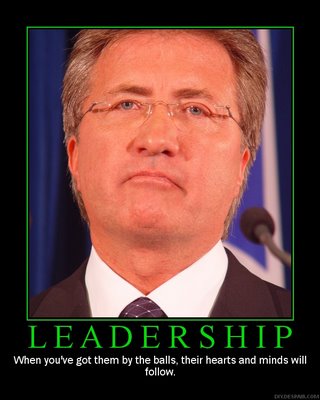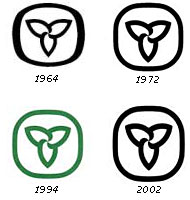So much for kissing and make up with the federal government.
Offal News has as good a take on the weekend events at the provincial Tory convention as you will find.
No small irony that a guy who only five years ago made fun of the provincial Liberal government fighting with the federal Liberal government is now in a situation where he is fighting with everyone, big or small, Tory or heretic.
 [Photo: Premier Danny Williams and finance minister Loyola Sullivan plan their next war with Ottawa in advance of the 2007 provincial general election. Not exactly as illustrated]
[Photo: Premier Danny Williams and finance minister Loyola Sullivan plan their next war with Ottawa in advance of the 2007 provincial general election. Not exactly as illustrated]This is the New Approach, for sure.
 Meanwhile, Canadian Press has reported on the weekend events (see below). For some reason, CP did not get any quotes on the Slander in Gander donnybrook from deputy premier Tom Rideout [Photo, right, exactly as illustrated]
Meanwhile, Canadian Press has reported on the weekend events (see below). For some reason, CP did not get any quotes on the Slander in Gander donnybrook from deputy premier Tom Rideout [Photo, right, exactly as illustrated]Question: Is this the first time Premier Danny Williams has taken it upon himself to tell what went on in a private meeting only for us to discover later that what Danny said and what actually happened were two entirely different things?
Update: Here's the answer to the question. Danny Williams claimed Stephen Harper was prepared to consider so-called fallow field legislation for the offshore. Williams is looking for the legal power to force development of offshore fields. He raised the idea after failing to achieve a deal on Hebron.
CBC Radio is reporting this morning a statement from the Prime Minister's Office which rejects the idea. The PM never agreed to consider or think about it apparently. Take note of the reference in the CBC story to contracts fairly negotiated or something along those lines.
This seems like an oblique reference to the issues of bad faith bargaining raised here about Danny Williams' approach to negotiations with the oil companies. Steve doesn't likely read the Bond Papers, but he seems to be talking about the same issue and heading to the same conclusion about Danny.
Williams takes aim at Ottawa in drive for re election in Newfoundland
The Canadian Press
Oct 15, 2006
By Tara Brautigam
GANDER, N.L. (CP) _ Newfoundland Premier Danny Williams hopes to capitalize on a growing standoff with Ottawa in his quest for province-wide dominance in next year's provincial election.
Williams rallied his party at a weekend Progressive Conservative convention in Gander, with a fiery speech that drew a deep line between himself and Prime Minister Stephen Harper.
The premier warned Saturday night that he would urge Newfoundlanders to vote against Harper in the next future federal election if the province loses out in a revised equalization formula.
Hours earlier, Williams and Harper met in an effort to resolve their differences over several thorny issues, including a revised equalization formula. But their discussion about equalization only further chilled relations between the two Tory leaders.
The meeting was "heated,"' one of the premier's staffers said Sunday. [Ed note: This likely means the Premier was shouting, as he is wont to do, while the other person is being calm and professional.]
Williams has made a political career of fighting the federal government.
In December 2004, he pulled down the Canadian flags from provincial buildings during talks for a revamped Atlantic Accord to give Newfoundland full protection against equalization clawbacks on offshore royalties.
In early January, the flags went back up, and an agreement was reached after marathon talks in Ottawa a month later.
"Fighting the enormous resources of the federal government and achieving a new deal on the Atlantic Accord is not easy, but that doesn't mean it's impossible,"' Williams told about 600 supporters Saturday, indicating he would step up his battle against Ottawa before his re-election campaign.
"Stay tuned, you might be into round two before this one is all over."'
Williams also warned the party not to take the Oct. 9, 2007 election for granted, a message echoed by party president John Babb.
"A quick clean sweep? Who knows?"' Babb said. "But from our point of view, we're not making any predictions."
The Progressive Conservatives can make big gains in the next election, observers say.
At least two polls this year suggested Williams enjoyed an approval rating above 70 per cent, despite a government spending scandal that led to the resignation of Ed Byrne, one of his top cabinet ministers, in June.
But the Liberals have slammed Williams for neglecting rural Newfoundland and Labrador, areas beset by waves of residents moving to Alberta for work because of mass layoffs from the forestry and fisheries industries.
Currently there are 35 Progressive Conservatives in the provincial legislature, 11 Liberal members and one New Democrat.
A byelection has been called for Nov. 1 to fill a vacant seat in the Signal Hill-Quidi Vidi riding in St. John's, where high profile criminal lawyer Jerome Kennedy will run for the Tories against NDP Leader Lorraine Michael.
The Liberals are not running a candidate.













